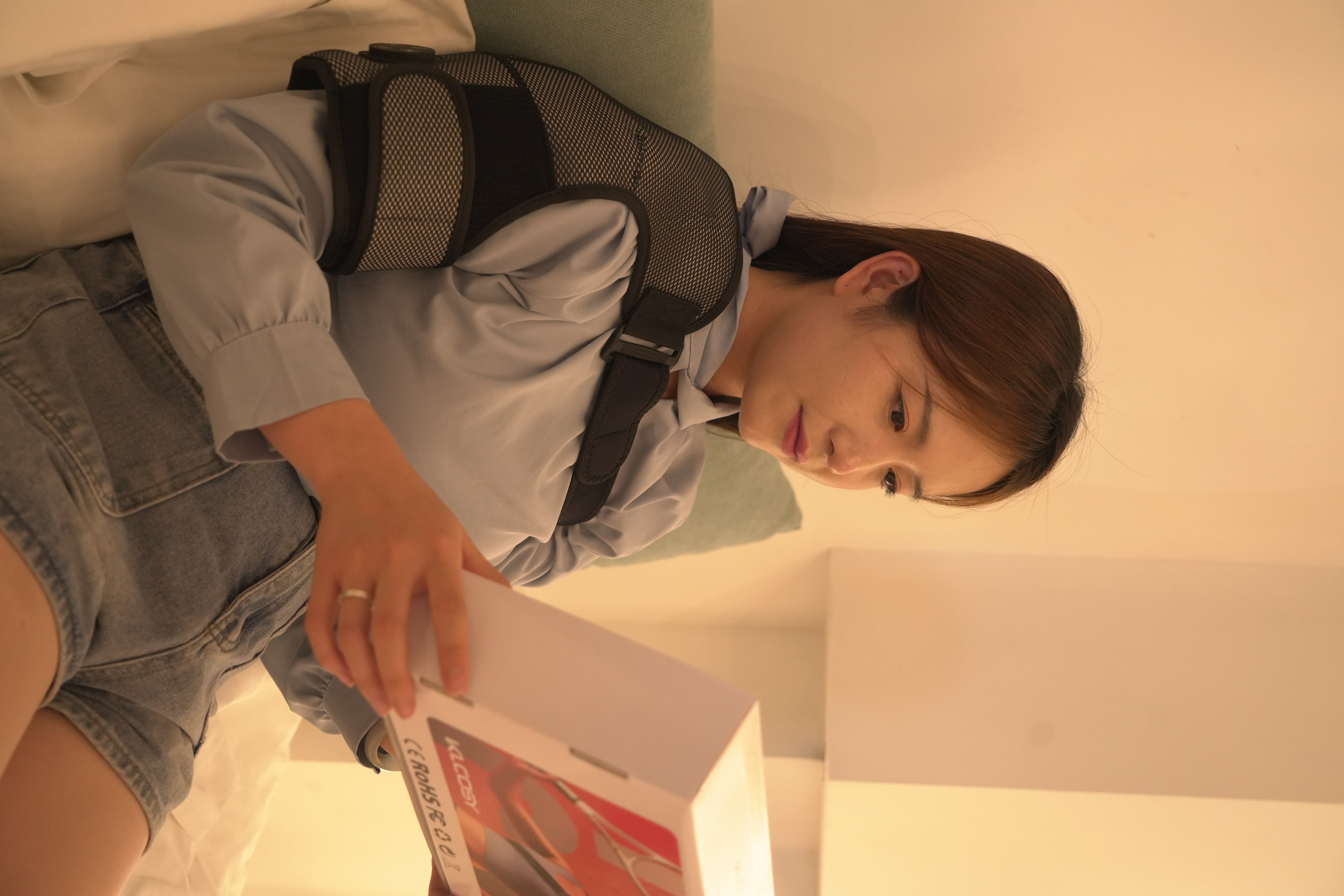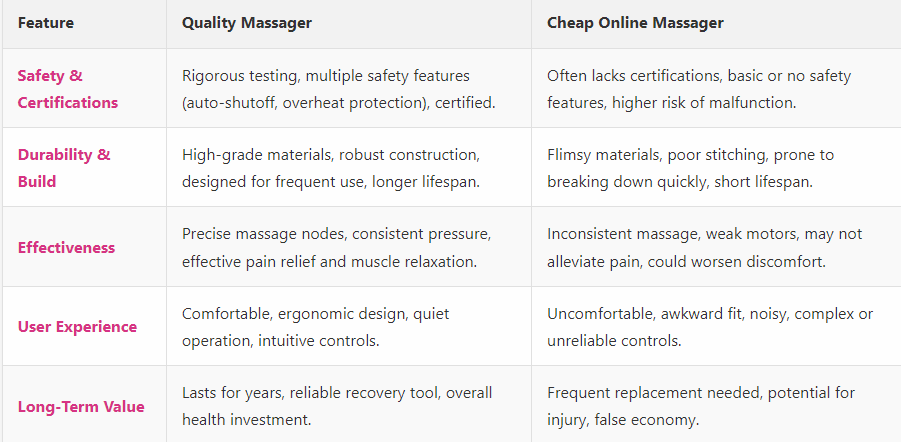Is a Best Massager for Neck and Shoulder Gold Coast Surfers' Secret?
- By Tony
- Updated on
Life on the Gold Coast is synonymous with sun, sand, and surf. The allure of the waves and the refreshing ocean beckons fitness enthusiasts to engage in exhilarating water sports. But let's be honest, after a vigorous surf session or an intense swim, your shoulders and neck often bear the brunt, screaming for relief. You might be wondering, can a simple, affordable shoulder and neck massager truly be the secret weapon for quick recovery, or is it a gamble with potential new injuries due to questionable quality?
This is a question I hear often from the active community here. As someone who helps people achieve optimal well-being and recovery, I've seen firsthand the debate around these devices. Do they offer revolutionary relief, or are they a false economy? Let’s dive deep into the science, benefits, and potential pitfalls of using a best massager for neck and shoulder after your Gold Coast adventures.
Understanding Post-Workout Tension in Your Neck and Shoulder
For Gold Coast fitness enthusiasts, the active lifestyle often means pushing your body. Surfing, for instance, involves constant paddling, quick movements, and holding specific postures, placing immense strain on your upper back, shoulders, and neck. Similarly, swimming, paddleboarding, and other water sports can lead to repetitive stress and muscle fatigue. This isn't just a minor ache; it's often delayed onset muscle soreness (DOMS), which can significantly impact your next session if not addressed.
Without proper recovery, that lingering tension can accumulate, potentially leading to chronic discomfort or even limiting your range of motion. Effective recovery isn't just about resting; it's about actively aiding your muscles to repair and relax. This is where tools designed for targeted relief, like a quality shoulder massager, truly shine. Many people underestimate how much stress their back neck shoulder massage takes during daily activities, let alone intense workouts.
- Paddling muscles (lats, triceps, deltoids)
- Core engagement muscles (obliques, rectus abdominis)
- Stabilizer muscles (rotator cuff, rhomboids)
- Postural muscles (trapezius, erector spinae)
The Science Behind Your neck and shoulder massager with heat
So, how exactly does a massager work its magic? At its core, these devices utilize various mechanisms to stimulate blood flow, relax muscle fibers, and reduce inflammation. Common features include targeted vibration, soothing heat, and even air compression. Vibration therapy helps to disrupt pain signals and promote circulation, delivering essential nutrients to fatigued muscles while flushing out metabolic waste. Heat therapy, often a beloved feature in a neck and shoulder massager with heat, penetrates deep to warm tissues, increasing elasticity and further enhancing blood flow.
I've noticed from my experience that for broad relaxation and gentle tension release, a dedicated shoulder massager can often be more effective than, say, a high-impact massage gun. While massage guns excel at deep tissue percussion on larger muscle groups, the consistent, encompassing pressure and multi-modal features (like air pressure,vibration,heat and red light) of a good shoulder massager can provide a more holistic relaxation experience for the often-delicate neck and shoulder area. It's about finding the right tool for the job.
- Vibration: Stimulates blood circulation and nerve endings, reducing perceived pain.
- Heating: Loosens tight muscles, improves elasticity, and increases blood flow for recovery.
- Air Pressure: Provides a compression massage, mimicking manual squeezing to reduce swelling and promote lymph drainage.
- Red Light: (In some advanced models) May aid cellular repair and reduce inflammation.

Real Benefits for Active Lifestyles and Beyond
For the Gold Coast sports enthusiasts, the promise of a best massager for neck and shoulder isn't just theoretical; it's about practical, tangible relief. Imagine finishing a demanding surf session and being able to quickly alleviate that burning sensation in your traps and deltoids. Many sports enthusiasts swear by these devices as "revolutionary" tools for quick recovery and tension relief, noting their immediate impact on post-exercise soreness. The convenience of having this recovery tool at home is, quite frankly, unparalleled.
Beyond post-workout recovery, these devices offer significant advantages for a broader audience. For elderly individuals grappling with chronic conditions like rheumatoid arthritis, a massage device can be an incredibly effective tool for daily pain management. Considering the thriving tourism industry on the Gold Coast, the cost of professional massage parlors is relatively high. Using a quality device at home offers both convenience and remarkable cost-effectiveness, proving that a targeted massage for shoulder pain doesn't have to break the bank.
- Rapid muscle relaxation and tension relief.
- Enhanced blood circulation, aiding faster recovery.
- Convenient and cost-effective daily pain management.
- Improved flexibility and range of motion in the shoulder and neck.
Choosing Your Best Massager for Neck and Shoulder Wisely
Here’s where we tackle the controversy: not all massagers are created equal. While the market is flooded with seemingly attractive, cheap massage devices available online, some users have reported significant quality issues. Stories of burns, skin abrasions, and even worsened muscle injuries or nerve problems after using low-quality products are unsettling. As your portable recovery expert, I can't stress enough: cutting corners on something that directly impacts your health is a gamble you don't want to take.
Key Features for a Wise Investment
When selecting your best massager for neck and shoulder, prioritizing safety and reliability over a rock-bottom price is paramount. Adjustable settings for intensity, heat, and pressure are crucial, allowing you to tailor the experience to your specific needs and avoid over-stressing sensitive areas. Beyond that, always look for safety certifications and robust construction materials. Investing in quality means investing in your well-being, rather than risking further injury while attempting to alleviate existing discomfort.
- Adjustable Settings: Look for variable intensity levels, heat settings, and different massage modes to customize your experience.
- Safety Certifications: Ensure the device has recognized safety marks (e.g., CE, RoHS, FCC) indicating it meets health and safety standards.
- Material Quality: The fabric and internal components should be durable, skin-friendly, and easy to clean, preventing skin irritation.
- Overheating Protection: A vital safety feature that automatically shuts off the device if it gets too hot, preventing burns or damage.
To really highlight the difference, let's look at a quick comparison:

As you can see, doing your homework on the best massager for neck and shoulder really pays off. It's about protecting yourself and getting the most out of your investment.
Maximizing Your Recovery: Tips and Complementary Tools
Once you have your quality shoulder massager, proper usage is key. Start with lower intensity settings, especially if you're new to using the device or have particularly sore muscles. Gradually increase the intensity as your muscles warm up and you become comfortable. Remember to hydrate well before and after use, as this aids in flushing out lactic acid and supports muscle recovery. Listen to your body; if something feels uncomfortable or painful, stop immediately. Knowing how to massage your own shoulders effectively with the device means paying attention to its ergonomic design and your body's feedback.
While a neck and shoulder massager with heat is a fantastic tool, it's part of a larger recovery ecosystem. For chronic issues or injuries, complementary tools like a shoulder strap for posture, a rotator cuff brace, or a shoulder support brace might be necessary. These aren't massagers, but they offer stability and support that can be crucial for healing and preventing future injuries. A holistic approach to recovery involves understanding when to massage, when to support, and when to seek professional help.
- Start Low, Go Slow: Begin with the gentlest setting.
- Hydrate: Drink water before and after your session.
- Listen to Your Body: Stop if you feel any sharp or increasing pain.
- Consistent Use: Regular short sessions are often more effective than infrequent long ones.
- Complement with Stretching: Gentle stretches can enhance the benefits of massage.
When a Massager Isn't Enough: Seeking Expert Guidance
For all their benefits, massagers have their limitations. While a best massager for neck and shoulder can offer significant relief for muscle tension and general soreness, it's not a substitute for professional medical advice or treatment. If you experience persistent or worsening pain, numbness, tingling, or any signs of nerve involvement, it's crucial to consult a healthcare professional. These symptoms can indicate more serious underlying conditions that require a proper diagnosis and tailored treatment plan.
For instance, is massage good for shoulder impingement? While massage can certainly help alleviate some of the accompanying muscle tension, shoulder impingement is a structural issue often requiring specific physical therapy exercises, and sometimes even medical intervention. Relying solely on a massager for such conditions could potentially delay proper treatment and worsen the problem. My advice is always to use massagers as a supportive tool within a comprehensive wellness strategy, guided by professional insights when needed. Ultimately, your long-term health is paramount.
- Sharp, shooting pain that doesn't subside.
- Numbness or tingling extending down the arm or into the hands.
- Significant weakness or inability to lift the arm.
- Swelling or bruising that doesn't improve.
- Pain following a specific injury or trauma.
So, is a shoulder and neck massager your best massager for neck and shoulder recovery companion on the Gold Coast? The answer, from my perspective, is a resounding yes, provided you choose wisely. For active individuals and those managing daily discomfort, a high-quality device can be a game-changer, offering convenient, cost-effective relief that complements your dynamic lifestyle.
But remember, quality truly matters. Don't compromise your health with cheap imitations. Invest in a reliable device, use it safely, and always listen to your body. Your recovery journey deserves the best massager for neck and shoulder, one that empowers you to keep enjoying the Gold Coast waves and maintain a vibrant, active life without unnecessary discomfort. Keep exploring, keep moving, and recover smart!
Frequently Asked Questions
How to massage your own shoulders?
Using a dedicated shoulder and neck massager is an excellent way to massage for shoulder areas yourself. Position the device over your shoulders and neck, ensuring the massage nodes or pads make good contact. Start on a low setting and gradually increase intensity. Move the device slightly to target different muscle groups. Many models are designed ergonomically to fit over your shoulders for hands-free use. Remember to relax your muscles as much as possible during the massage for the best results.
Will massage help shoulder pain?
Yes, massage can significantly help alleviate many types of shoulder pain, especially those caused by muscle tension, overuse, or stress. Massage helps improve blood circulation, reduce muscle tightness, and release endorphins, which are natural pain relievers. For generalized soreness or stiffness, a neck and shoulder massager with heat can provide effective relief. However, for chronic or sharp pain, it's important to understand the underlying cause and potentially seek professional advice to ensure massage is the appropriate treatment.
Is massage good for shoulder impingement?
For shoulder impingement, massage can be a beneficial part of a broader treatment plan, but it's crucial to approach it carefully. While massage can help relax surrounding muscles that might be tight and contributing to the impingement, it won't directly resolve the structural impingement itself. It can improve blood flow and reduce pain in the associated muscles. I always recommend consulting a physical therapist or doctor for shoulder impingement to get a proper diagnosis and tailored exercise regimen. Massage should complement, not replace, professional medical guidance for this specific condition.




